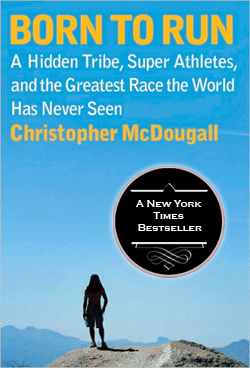 It's always funny to me how sometimes I'll hear about something like a book or a song and then suddenly I stumble upon in almost immediately afterwards. This happened to me recently with Born to Run by Christopher McDougall. My former student teacher and I had been talking about running and she mentioned the book to me in passing and not a week later my mom mentioned that a friend of hers had sent a book for me to read, but she was already so engrossed in the book that I'd have to wait until she finished it and sent it along my way. Serendipity? Quite possibly. So, sure enough, once dear old mom had finished up the book and sang its many praises, she left it with me, and she seemed curious to hear what my reaction would be to it since I run on a near-daily basis.
It's always funny to me how sometimes I'll hear about something like a book or a song and then suddenly I stumble upon in almost immediately afterwards. This happened to me recently with Born to Run by Christopher McDougall. My former student teacher and I had been talking about running and she mentioned the book to me in passing and not a week later my mom mentioned that a friend of hers had sent a book for me to read, but she was already so engrossed in the book that I'd have to wait until she finished it and sent it along my way. Serendipity? Quite possibly. So, sure enough, once dear old mom had finished up the book and sang its many praises, she left it with me, and she seemed curious to hear what my reaction would be to it since I run on a near-daily basis.My reaction? Is it possible to run and read at the same time? I found myself drawn to reading and simultaneously wanting to work out too to test out some of the notions presented in the book. I loved the combination of the genres with this book. It starts off as a running/medical narrative and then morphs into an anthropological study of the Tarahumara tribe of Mexico. It then ties in some of the craziest distance running competitions and the wackos who compete and excel at these competitions. Then, before I knew it, all of these topics were being tied together in an Outside Magazine-like story about excessive personalities and how these ultra-runners, though so different, are drawn together through this compulsion.
Did I mention that I'll never look at running shoes and Nike the same way again? Nor the human body and our "SAD" diets. This book amazed me in that I learned so much and found myself increasingly persuaded to want to go shoeless and throw off the shackles of a diet laden with meat and animal by-products. At the same time, it wasn't preachy; it just presented the facts. Why was I so convinced? I was convinced because I could legitimately feel the author's struggle and natural progression from amateur runner and a force to be reckoned with... particularly because he achieved the goal he'd hoped: increased mileage and increased speed without the hampering injuries. I think I found what I'll be spending my Barnes and Nobles giftcards on... volumes of "Born to Run" for friends and family.


